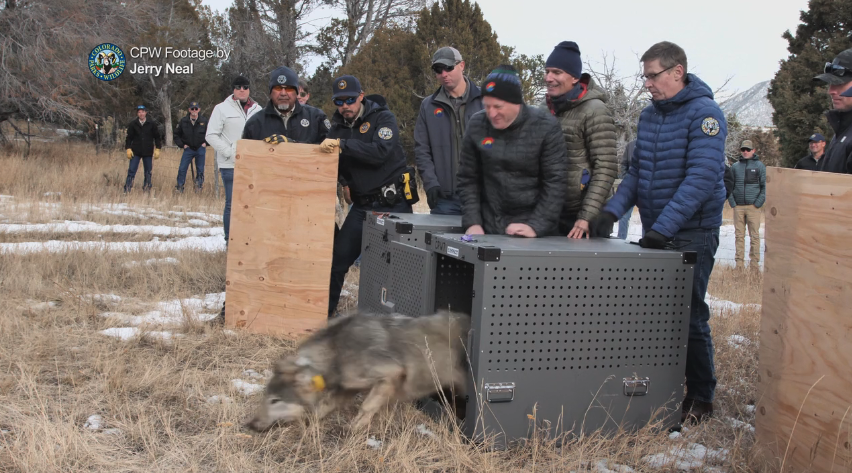UPDATE | Nov. 14 — Colorado Parks and Wildlife updated its list of potential counties to release wolves this winter as part of the voter-mandated reintroduction process. The counties currently being considered are Garfield County, Eagle County, and Pitkin County.
"Rio Blanco County was removed as a potential location as the next level of analysis was conducted due to the limited number of state-owned sites that adhered to the criteria in the plan and their proximity to livestock, elevating the risk of conflict, as well as the potential impact to elk and deer herds recovering from the severe winter of 2022-23," CPW said in its update. "Another consideration was adjacency to existing wolves on the landscape."
...
DENVER — Ahead of the next round of gray wolf reintroductions this winter, Colorado Parks and Wildlife (CPW) staff met with leaders of the counties where the wolves may be released.
CPW Director Jeff Davis and Northwest Regional Manager Travis Black, as well as Area Wildlife Managers and Wolf Program staff, met with county commissioners and other leaders from Rio Blanco County, Garfield County, Eagle County and Pitkin County in Rifle on Friday.
CPW said it is considering releasing the wolves in one or more of those counties between December and March, and wanted to communicate why and how it would do that, while also listening to questions and feedback from the commissioners' communities.
"We recognize that this is a challenging situation and all involved are listening to their constituents," Davis said. "We wanted to create an opportunity for officials to have their questions answered and to understand how we can assist our local partners in informing their communities."
The first round of wolf reintroductions in December 2023 happened in Grand County and Summit County, where 10 wolves were released on the landscape. In the near-year since then, they have traveled well beyond those counties.
The map below shows the watersheds where the wolves have traveled most recently.

"As we move forward with the Colorado Wolf Restoration and Management Plan, which is mandated by law, we are committed to having conversations with local elected officials and communities near possible release areas,” Davis said.
The Colorado Wolf Restoration and Management Plan, which was finalized in May 2023, illustrated a northern and southern zone option for the reintroductions. The first one was — and the upcoming second will be — in the northern zone.

Local area wildlife managers and biologists, as well as wolf program biologists, identified state-owned lands within that zone that can support the release of multiple wolves this winter. The experts will take into account how much natural prey is in the area, access, and equipment needed for the release, as well as social considerations, like likelihood of interactions between wolves and humans or livestock.
CPW said its staff will also keep in mind that the gray wolves will likely wander far from the release point. Several wolves "made significant movements" in the months after the December 2023 release, as was expected, CPW said.
"The meeting on Nov. 8 in Rifle marks the beginning of the collaboration efforts as we enter the next phase of gray wolf introductions and continues the discussions that have been taking place since January 2024," CPW said.
Davis told Denver7 in an exclusive September interview that CPW had learned "a big lesson" after the 2023 reintroduction about spending more time communicating with county electeds ahead of a wolf release. In addition to meetings like the one Friday in Rifle, CPW and the Colorado Department of Agriculture hosted several Conflict Reduction Training sessions in northwest Colorado, focused on preparing producers ahead of calving season, which is typically in the early spring. More trainings are scheduled for Eagle and Gunnison counties in December.

Environment
Colorado agencies offer trainings on how to keep wolves away from livestock
The wolves for the second round of reintroductions will come from British Columbia.
British Columbia is home to wolf packs that thrive in areas with little to no livestock presence, Davis said in September, which lines up with Colorado's efforts to ensure the wolves it translocates do not have a concerning depredation history. British Columbia also has an abundant elk population, which are wolves' natural prey, so the sourced wolves will already recognize elk and deer as prey once they arrive in Colorado, Davis said.
Colorado has a healthy elk population — 303,000 as of 2023 — and CPW is not anticipating any sort of similar recovery plan for those animals in Colorado, he added.
Colorado is currently home to 14 known wolves: Two that moved south into Jackson County from Wyoming, seven surviving from the 2023 reintroduction, and five pups. One of the adult females and four of her pups, all members of the Copper Creek Pack, were captured in September after multiple livestock depredation incidents and are at a large, secure and undisclosed enclosure while CPW evaluates them. A fifth pup could not be captured.
“As restoration efforts continue, CPW is focused on supporting an environment where livestock producers, communities, state agencies and partners work both individually and together in order to reduce the likelihood of wolf-livestock conflict," Davis said. "Effective and innovative solutions will result from this local expertise and extended, respectful collaboration. These relationships are critical to the success of wolf restoration in Colorado while at the same time supporting agricultural and rural communities and the vital role they play in Colorado’s economy, heritage and conservation efforts."








